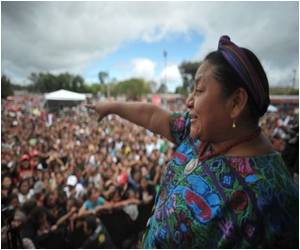The last thing on Jay Blevins' mind is the Mayan end of the world, but if it happens, he and his family are more than ready for it.

"We could survive for quite a while just on this stuff," Blevins said.
Out in the backyard where fruits and berries grow, barrels of fresh water stand under the eaves. Safely locked away is a small arsenal of pistols and semi-automatic rifles, all the better to hunt game and scare off looters.
And if the Blevins should have to make tracks, every member of the family has their own "bug-out bag" -- a backpack filled with on-the-road essentials from a katana samurai sword to toys and games for the kids.
"I don't think we've spent too much money. I don't think we've gone overboard," father-of-three Blevins, 35, a business consultant and former deputy sheriff and SWAT team officer, told AFP.
-- 'It's just like insurance' --
Advertisement
Blevins is a "prepper," one of a growing number of Americans making big plans for bad times, be it economic chaos, climate change, terrorism, natural disasters like the recent Hurricane Sandy or just a very long power outage.
Advertisement
Some of the more outgoing members of the movement, like Blevins, feature in season two of "Doomsday Preppers," a National Geographic Channel reality TV series, now airing worldwide.
"It's kind of this natural homegrown American thing that's just catching on with more suburbanites," said Mike Porenta of the American Preppers Network, an online forum for local prepper meet-up groups all over the United States.
Prepping enjoys a degree of tacit government endorsement: the Federal Emergency Management Agency (FEMA), on its ready.gov website, tells citizens to put together a basic disaster kit with food and water for three days.
But why stop there? Preppers can shop online for everything from a year's supply of food for one person ($1,152 from Walmart) to pre-fabricated underground bunkers to sit out a nuclear, biological or chemical attack.
In California, the Vivos Group markets luxury bunkers for anyone from a family of four ("discreetly installed just about anywhere in one week") to a community of 1,000 people outfitted for a year of survival.
"Members need to only arrive before their facility is locked down and secured from the chaos above," it says.
On a more modest and practical scale, 1-800-Prepare.com peddles a range of made-in-USA survival kits for individuals, families, offices, even dogs and cats -- and in the aftermath of Sandy, it's seen its sales explode ten-fold.
"My typical client is the everyday American, the mainstream consumer," said its owner, New York area volunteer firefighter Paul Faust, who turns over a slice of his post-Sandy profits to a disaster relief charity.
James Stevens, 73, alias Dr Prepper, who lives on a secluded hilltop outside San Antonio, Texas with five years' supply of food and his own water supply, has been prepping since 1974.
That was the year of the Arab oil embargo, which put paid forever to many Americans' belief in a bottomless supply of cheap energy as they lined up for hours to fill up their cars.
"You prepare for the lifestyle you'd like to maintain when things over which you have no control take control," said Stevens, who's sold 800,000 copies of his "Family Preparedness Handbook," now in its 12th edition.
The Mayan end of the world? "It's the last thing I'm worried about," Stevens told AFP by telephone. "I'm more concerned about the economic, political and moral situation."
Despite its guy-thing image, mother-of-two Lisa Bedford, whose blog TheSurvivalMom.com gives useful tips on how to weather a disaster with a brood of boisterous kids, considers prepping "a very natural fit" for women.
"We start preparing for a baby even before we start getting pregnant," said Bedford, who keeps a three-month supply of Spam, chili and peanut butter in the house, plus a survival kit in the car to hold out for 72 hours with kids.
"I want my family to be less vulnerable, no matter what happens," she added. "There is power in being proactive."
Back in Berryville, Blevins -- whose own mother knows a thing or two about survival, having lived through war in her native Vietnam before coming to the United States -- acknowledges "a fine line between preparation and paranoia."
But he puts his passion for prepping into context.
"Since 2000, in this state (Virginia), we've had 17 major disaster declarations, everything from the September 11 terrorist attacks to earthquakes to hurricanes to blizzards," he said.
"As a husband and a father, I want to make sure that my family is prepared, really, for anything that will come."
Source-AFP









